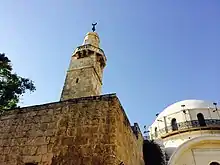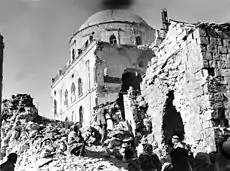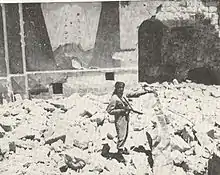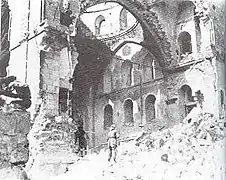Islamization of Jerusalem
The Islamization of Jerusalem refers to the religious transformation of the Levantine city that occurred three times in history. The first Islamization of Jerusalem followed the Muslim conquest of Jerusalem under Umar ibn Al-Khattāb in 638 CE. The second Islamization followed the fall of the first Crusader Kingdom of Jerusalem in 1187, leading to an almost uninterrupted seven centuries long period of Muslim rule with a dominant Islamic culture, during the Ayyubid, Mamluk and early Ottoman periods. Beginning in the late Ottoman era, Jerusalem’s demographic turned increasingly multi-cultural, regaining a majority Jewish character during the late 19th and early 20th century that hadn’t been seen since the Roman era.[1] However, with the Jordanian annexation of the West Bank, Jerusalem underwent another round of Islamization and Arabization.

| Part of a series on |
| Jerusalem |
|---|
-Aerial-Temple_Mount-(south_exposure).jpg.webp) |
| Sieges |
| Places |
| Political status |
| Other topics |
The remodulation was grounded on a foundational narrative in early Islamic texts, themselves drawing on Persian, Jewish and Christian traditions[2] that emphasized the city's cosmological significance within God's creation.[3] At the time of the Muslim conquest of the city, the victors encountered many traditions concerning the Temple Mount: Muslim beliefs regarding David (the miḥrāb Dāwūd in the Qur'an 38:20-21) and Solomon;[4] shared beliefs that from there, on Mount Moriah (the “mountain” that the Temple Mount sits upon) Adam had been born and died;[5] shared beliefs that Mount Moriah was also where Abraham almost sacrificed one of his sons; and they absorbed the Christian belief that Zechariah, John the Baptist’s father (in the Qur'an, 'prophet of the Jewish scholars') raised a mihrab to Mary, the mother of Jesus on the site.[6] These and other such traditions affected the outlay of Islamic buildings. It has also been argued that the central role Jerusalem assumed in Islamic belief began with Muhammad's instruction to his followers to observe the qibla by facing the direction of Jerusalem during their daily prostrations in prayer.[7] After 13 years (or 16 months,[8] depending on the source),[9] due to both divine guidance[10] and practical matters (souring of relationship with the Jews[7] and/or Muhammd’s frustration with the city and its people[11]) the direction of prayer was changed to Mecca in present-day Saudi Arabia.[12] The Umayyad construction of the Dome of the Rock was interpreted by later hostile Abbasid historians as an attempt to redirect the Hajj, or pilgrimage, from Mecca to Jerusalem.[13]
Although Jerusalem is not mentioned by any of its names in the Quran, it is mentioned in later Islamic literature and in hadiths, as the place of Muhammad's ascension to heaven.[14] The Qur'anic reference to a masjid al-aqṣā originally referred to one of two sanctuaries at al-Ji'ranah near Mecca, the other being masjid al-adnā,[15] The Umayyad caliphate exploited these traditions connecting Muhammad’s night journey specifically to Jerusalem and, in the face of some concerted opposition, particularly from Shiites, their claim prevailed.[16]
First Islamization of Jerusalem under the Caliphates
In 638 CE, the Islamic Caliphate extended its dominion to Jerusalem.[17] With the Arab conquest of the region, Jews were allowed back into the city.[18] While the majority population of Jerusalem during the time of Arab conquest was Christian,[19] the majority of the Palestine population of about 300,000-400,000 inhabitants,[20] was still Jewish. In the aftermath the process of cultural Arabization and Islamization took place, combining immigration to Palestine with the adoption of Arabic language and conversion of a part of the local population to Islam.[21] According to several Muslim scholars, including Mujir ad-Din, al-Suyuti, and al-Muqaddasi, the mosque was reconstructed and expanded by the caliph Abd al-Malik in 690 along with the Dome of the Rock.[22][23] In planning his magnificent project on the Temple Mount, which in effect would turn the entire complex into the Haram al-Sharif ("the Noble Sanctuary"), Abd al-Malik wanted to replace the slipshod structure described by Arculf with a more sheltered structure enclosing the qibla, a necessary element in his grand scheme. The Jewish background in the construction of the Dome of the Rock is commonly accepted by historians. A number of scholars consider the construction of the Dome as the Muslim desire to rebuild Solomon's Temple or Mihrab Dawud. Grabar and Busse claimed that this was the primary Islamic legitimization for the sanctity of the Dome of the Rock, while the al-mi'raj traditions were transferred to the rock only later.[24] An early Islamic tradition from the converted rabbi Ka'ab al-Ahbar states "Ayrusalaim which means Jerusalem and the Rock which means the Temple. I shall send you my servant Abd al-Malik who will build you and adorn you. I shall surely restore you to Bayt Al Maqdis, its first kingdom and I shall crown it with gold, silver and gems. And I shall surely send you my creatures. And I shall surely invest my throne of glory upon the rock, since I am the sovereign God, and David is the king of the Children of Israel."[25]
Under the Rashidun Caliphate
The Rashidun caliph Umar ibn al-Khattab signed a treaty with Miaphysite Christian Patriarch Sophronius, assuring him that Jerusalem's Christian holy places and population would be protected under Muslim rule.[26] When led to pray at the Church of the Holy Sepulchre, the holiest site for Christians, the caliph Umar declined to pray within the church in order not to establish a precedent that might be exploited later by some Muslims to convert the church into a mosque. He prayed outside the church, where the Mosque of Umar (Omar) stands to this day, opposite the entrance to the Church of the Holy Sepulchre.
However, some of the most prominent Orientalists and historians of Early Islam, such as Heribert Busse, Moshe Sharon and Oleg Grabar, doubt that caliph Umar ibn al-Khattab had ever visited Jerusalem. The earliest Islamic sources attribute conquest of Jerusalem to a commander by the name Khālid b. Thābit al-Fahmi, whereas Umar appears only in sources written some two centuries after Muslim conquest of the city.[27]
According to the Gaullic bishop Arculf, who lived in Jerusalem from 679 to 688, the Mosque of Umar was a rectangular wooden structure built over ruins which could accommodate 3,000 worshipers.[28]
Under the Umayyad and Abbasid Caliphate
The Umayyad caliph Abd al-Malik commissioned the construction of the Dome of the Rock in the late 7th century.[29] The 10th century historian al-Muqaddasi writes that Abd al-Malik built the shrine in order to "compete in grandeur" with Jerusalem's monumental churches.[28] Over the next four hundred years Jerusalem's prominence diminished as Arab powers in the region jockeyed for control.[30]
During Rashidun Caliphate, Umayyad Caliphate and some two centuries of Abbasid Caliphate the name of the city was not known by Muslims. Jerusalem was called Iliya and later al-Bayt al-Muqaddas which comes from Hebrew Bait ha-Mikdash (בית המקדש). Name Iliya originated from Latin Aelia Capitolina, but Muslims apparently believed that the name was given after the Prophet Elijah.[27]

Under the Fatimid Caliphate
In 1099, The Fatimid ruler expelled the native Christian population before Jerusalem was conquered by the Crusaders, who massacred most of its Muslim and Jewish inhabitants when they took the solidly defended city by assault, after a period of siege; later the Crusaders created the Kingdom of Jerusalem. By early June 1099 Jerusalem’s population had declined from 70,000 to less than 30,000.[31]
Second Islamization of Jerusalem
Under the Ayyubid dynasty
In 1187, the city was wrested from the Crusaders by Saladin who permitted Jews and Muslims to return and settle in the city.[32] Under the Ayyubid dynasty of Saladin, a period of huge investment began in the construction of houses, markets, public baths, and pilgrim hostels as well as the establishment of religious endowments. However, for most of the 13th century, Jerusalem declined to the status of a village due to city's fall of strategic value and Ayyubid internecine struggles.[33]
Under the Mamluk Sultanate
In 1244, Jerusalem was sacked by the Khwarezmian Tartars, who decimated the city's Christian population and drove out the Jews.[34] The Khwarezmian Tartars were driven out by the Ayyubids in 1247. From 1250 to 1517, Jerusalem was ruled by the Mamluks. During this period of time many clashes occurred between the Mamluks on one side and the crusaders and the Mongols on the other side. The area also suffered from many earthquakes and black plague.
Third Islamization of Jerusalem under Jordanian rule

Jordan, although mandated by the UN to let Israeli Jews visit their holy sites, refused access to them. They also led a systematic destruction of the Jewish Quarter including many ancient synagogues.[35] Under Jordanian rule of East Jerusalem, all Israelis (irrespective of their religion) were forbidden from entering the Old City and other holy sites.[36] Between 40 000 and 50 000 tombstones from ancient Mount of Olives Jewish Cemetery were desecrated.[37] In the Old City of Jerusalem, the Jewish Quarter was destroyed after the end of fighting. The Tiferet Yisrael Synagogue was destroyed first, which was followed by the destruction of famous Hurva Synagogue built in 1701, first time destroyed by its Arab creditors in 1721 and rebuilt in 1864.[38][39][40] On its part, Israeli authorities destroyed part of Mamila Muslim cemetery, near the armistice line.[41] Altogether, the Jordanians destroyed 56 Synagogues in Jerusalem, while the remaining synagogues were used as toilets, stables and chicken coops.[42] All Jewish inhabitants from the parts of city ruled by Jordan, including residents of Old City Jewish Quarter were expelled. A 1955 law required all schools to use only government-approved textbooks and that students be taught only their own religion.[43] This provided universal education while limiting foreign Christian influence.[43]

Islamization of the Temple Mount
Muslim appropriated Islamicize the Temple Mount for exclusive Muslim use after the conquest of the city.[44] Originally an Israelite and subsequently Jewish holy site, as the location of the First and Second Temples, under the Byzantine Empire the site was essentially deserted,[45] though a public building may have been erected, perhaps a church, with an elaborate mosaic floor, some of the remains of which have been discovered by the Temple Mount Sifting Project.[46] In 682 CE, 50 years after Muhammad’s death, ‘Abd Allah ibn al-Zubayr rebelled against the Caliph of Damascus, conquered Mecca and thus, according to Ignaz Goldziher, stopped pilgrims from coming south to the Hajj in Mecca.[47] ‘Abd al-Malik, the Umayyad Caliph, responded by creating a new holy site. He chose sura 17, verse 1, “Glory to Him who caused His servant to travel by night from the Sacred Mosque to the Farthest Mosque, whose precincts We have blessed, in order to show him some of Our Signs, He is indeed the All-Hearing, the All-Seeing.” And designated the Temple Mount in Jerusalem as the "Farthest Mosque" mentioned in that verse.
Dome of the Rock
Monumental constructions made on the Temple Mount, exemplifying what Gideon Avni calls 'an outstanding manifestation of Islamic rule over Jerusalem,'[48] climaxed at the end of the seventh century, with the construction of the Dome of the Rock in the early 690s when Abd al-Malik was developing his program of Islamization. It was built over the Foundation Stone, the site of the historic Jewish Temple.[49] The al-Aqsa mosque was built at the southern end of the mount in the 8th-century.
Throughout the entire period of the Muslim conquest until the capture of Jerusalem in 1099, various structures were built on the mount including memorial sites and gates.[50]
From the 13th-century onwards, after the Muslims had regained control of the city, building projects in Jerusalem and around the Temple Mount sought to further establish the city’s Islamic character.[51]
After the conquest of the city by Saladin, non-Muslims were permitted to set foot on the Temple Mount.[52]
Al-Aqsa Mosque
It is unknown exactly when the al-Aqsa Mosque was first constructed and who ordered its construction, but it is certain that it was built in the early Umayyad period of rule in Palestine. Architectural historian K. A. C. Creswell, referring to a testimony by Arculf, a Gallic monk, during his pilgrimage to Palestine in 679–82, notes the possibility that the second caliph of the Rashidun Caliphate, Umar ibn al-Khattab, erected a primitive quadrangular building for a capacity of 3,000 worshipers somewhere on the Haram ash-Sharif. However, Arculf visited Palestine during the reign of Mu'awiyah I, and it is possible that Mu'awiyah ordered the construction, not Umar. This latter claim is explicitly supported by the early Muslim scholar al-Muthahhar bin Tahir.[22]
Post 1948 period of Jordanian rule to 1967

Destruction of Temple Mount antiquities, 1995–2001
Between 1995 and 2001, the Islamic Waqf carried out extensive construction work in order to build the biggest mosque in the region named Marwani mosque, with a capacity of 10,000 worshippers in an area of about 5,000 square meters. During unsupervised construction, the Waqf obliterated many of the antiquities at Solomon's Stables section of Temple Mount. The original Herodian structure was converted into a mosque. The structure stones were stripped of its original surface.[53] At eastern Hulda gate, the Waqf destroyed the original Herodian ornamentation and later plastered them and painted them over.[54] Tens of truck loads of dirt were dumped into Kidron Walley. Thousands of artifacts from the First Temple period until today were later rescued in the operation named Temple Mount Sifting Project. The findings included some 1000 ancient coins, Israelite bullas with ancient Hebrew inscriptions, 10,000-year-old tools like a blade and scraper, as well as Hasmonean, Ptolemaic and Herodian artifacts, ancient stones with signs of Second Temple destruction and other important artifacts.[55] The Waqf justified its action by calling the site a "mosque from the time of Adam and Eve" and by rejecting Jewish historical connection with the site.[56]
See also
References
- Shlomo Slonim, Jerusalem in America's Foreign Policy, 1947-1997, Martinus Nijhoff Publishers 1999 ISBN 978-9-041-11255-2 p.13
- Khoury p.57:’Persian, Jewish, and Christian-Byzantine elements were present in Arabia itself prior to the appearance of Islam, and were integrated into Arab history, tradition, and culture to become part of the collective heritage and memories that were recorded in the Islamic historical writings of later years. A particularly rich repertoire of Arab myths and memories, as well as architecture, thus preceded the appearance of the first Islamic monument.
- Zayde Antrim, Routes and Realms: The Power of Place in the Early Islamic World,Oxford University Press, 2012 p.48
- A brief guide to the Al-Haram Al-Sharif Jerusalem. [Place of publication not identified]. 1924. p. 4. ISBN 978-0-9710511-7-1. OCLC 852805293.
Its identity with the site of Solomon’s Temple is beyond dispute. This, too, is the spot, according to the universal belief, on which ‘David built there an altar unto the Lord, and offered burnt offerings and peace offerings’.
- Grabar pp.38-39
- Khoury, p.58
- Hoiberg, Dale (2000). Students' Britannica India. Popular Prakashan. p. 224. ISBN 978-0-85229-760-5.
- Yohanan Friedmann (2003). Tolerance and coercion in Islam: interfaith relations in the Muslim tradition. Cambridge University Press. p. 31.
- Mayer, Tamar; Mourad, Suleiman Ali (2008). Jerusalem: Idea and Reality. Routledge. p. 87. ISBN 978-0-415-42128-7.
- Sura 2 (Al-Baqara), ayah 144, Quran 2:144
- "Altafsir.com - The Tafsirs - التفاسير". www.altafsir.com. Retrieved 2020-03-03.
- Yitzhak Reiter, Marwan Abu Khalaf,'Jerusalem’s Religious Significance,' at Palestine-Israel Journal, Vol.8, No.1, 2001.
- Nuha N. N. Khoury, The Dome of the Rock, the Kaʿba, and Ghumdan: Arab Myths and Umayyad Monuments, in Muqarnas, Vol. 10, Essays in Honor of Oleg Grabar, Brill (1993), pp. 57-65, p.58.
- Historic Cities of the Islamic World edited by Clifford Edmund Bosworth P: 226
- Oleg Grabar, The Umayyad Dome of the Rock in Jerusalem, Ars Orientalis, Vol. 3 (1959), pp. 33-62 p.37.
- Yitzhak Reiter, Jerusalem and Its Role in Islamic Solidarity, Springer 2008 p.21.:’The issue of al-Aqsa Mosque's location has been subject to much debate within Islam, and even today there are those who believe it is not in Jerusalem at all, according to one claim, the text was meant to refer to the Mosque of the Prophet in al-Madina or in a place close to al-Madina. Another perception is that of the Ja’fari Shiites, who interpret that al-Aqsa is a mosque in heaven. This interpretation reflects the Shiite anti-Umayyad emotions in an attempt to play down the sacredness of Umayyad Jerusalem and to minimize the sanctity of Jerusalem by detaching the qur’anic al-Masjid al-aqsa from the Temple Mount, thus asserting that the Prophet never came to that city, but rather ascended to the heavenly al-Aqsa mosque without ever stopping in bayt al-Maqdis [Jerusalem]. Apart from depriving Jerusalem of its major attraction for pilgrims, the Shiite traditions offer alternative pilgrimage attractions such as the Shiite holy city of Kufa, as well as Mecca. However, the tradition about Muhammad’s Night Journey to Jerusalem were never suppressed. They were exploited by the Umayyads and continued to be quoted in the tafsir (Qur’an interpretation) collections. The interpretation dating from the Umayyad and Crusader eras, according to which al-Aqsa is in Jerusalem, is the one that prevailed.’’
- Jerusalem: Illustrated History Atlas Martin Gilbert, Macmillan Publishing, New York, 1978, p. 7
- Gil, Moshe (February 1997). A History of Palestine, 634–1099. Cambridge University Press. pp. 70–71. ISBN 0-521-59984-9.
- Nimrod Luz. "Aspects of Islamization of Space and Society in Mamluk Jerusalem and its Hinterland" (PDF). Mamluk.uchicago.edu. Retrieved 2015-10-23.
- Israel Cohen (1950). Contemporary Jewry: a survey of social, cultural, economic, and political conditions, p 310.
- Lauren S. Bahr; Bernard Johnston (M.A.); Louise A. Bloomfield (1996). Collier's encyclopedia: with bibliography and index. Collier's. p. 328. Retrieved 19 December 2011.
- Elad, Amikam. (1995). Medieval Jerusalem and Islamic Worship Holy Places, Ceremonies, Pilgrimage BRILL, pp.29–43. ISBN 90-04-10010-5.
- le Strange, Guy. (1890). Palestine under the Moslems, pp.80–98.
- Medieval Jerusalem and Islamic Worship: Holy Places, Ceremonies, Pilgrimage By Amikam Elad P:161
- Medieval Jerusalem and Islamic Worship: Holy Places, Ceremonies, Pilgrimage By Amikam Elad P:162-3
- Runciman, Steven (1951). A History of the Crusades:The First Crusade and the Foundation of the Kingdom of Jerusalem. Penguin Books. Vol.1 pp.3–4. ISBN 0-521-34770-X.
- Havel, Boris. "Jerusalem in Early Islamic Tradition". Miscellanea Hadriatica et Mediterranea, University of Zadar. Retrieved 2018-12-24.
- Shalem, Yisrael. "The Early Arab Period – 638–1099". Ingeborg Rennert Center for Jerusalem Studies, Bar-Ilan University. Retrieved 2008-07-20.
- Hoppe, Leslie J. (August 2000). The Holy City: Jerusalem in the Theology of the Old Testament. Michael Glazier Books. p. 15. ISBN 0-8146-5081-3.
- Zank, Michael. "Abbasid Period and Fatimid Rule (750–1099)". Boston University. Retrieved 2007-02-01.
- Hull, Michael D. (June 1999). "First Crusade: Siege of Jerusalem". Military History. Archived from the original on 2007-09-30. Retrieved 2007-05-18.
- "Main Events in the History of Jerusalem". Jerusalem: The Endless Crusade. The CenturyOne Foundation. 2003. Retrieved 2007-02-02.
- Abu-Lughod, Janet L.; Dumper, Michael (2007). Cities of the Middle East and North Africa: A Historical Encyclopedia. ABC-CLIO. p. 209. ISBN 978-1-57607-919-5. Retrieved 2009-07-22.
- Jerusalem: Illustrated History Atlas Martin Gilbert, Macmillan Publishing, New York, 1978, p.25.
- "S/8439* of 6 March 1968". Archived from the original on 28 September 2008. Retrieved May 25, 2011.
- Martin Gilbert, Jerusalem in the Twentieth Century (Pilmico 1996), p254.
- Meron Benvenisti, City of Stone: The Hidden History of Jerusalem P: 241
- "האתר הרשמי של עיריית ירושלים". Jerusalem.muni.il. Archived from the original on 2013-09-21. Retrieved 2015-10-23.
- Balint, Benjamin (2010-03-10). "Benjamin Balint: Rebuilding the Hurva in the Holy Land - WSJ". Online.wsj.com. Retrieved 2015-10-23.
- Reinventing Jerusalem: Israel's Reconstruction of the Jewish Quarter After 1967 By Simone Ricca P:105
- The Meeting of Civilizations: Muslim, Christian, and Jewish edited by Moshe Ma'oz P.103
- The Jerusalem Question and Its Resolution: Selected Documents edited by Rût Lapîdôt, Moshe Hirsch P.384
- Kimberly Katz (2005). Jordanian Jerusalem; Holy Places and National Spaces. University Press of Florida. pp. 97–99. ISBN 0-8130-2844-2.
- Raphael Israeli (2003). War, peace and terror in the Middle East. Psychology Press. pp. 21–. ISBN 978-0-7146-5531-4. Retrieved 3 October 2010.
During the process of the Islamization of Jerusalem, a mosque was built on the site...The Islamicized Mount became the destination of Muhammad's isra’...
- Gideon Avni, The Byzantine-Islamic Transition in Palestine: An Archaeological Approach , Oxford University Press 2014 ISBN 978-0-199-68433-5 p.132
- "Was the Aksa Mosque built over the remains of a Byzantine church?,", Etgar Lefkowitz, November 16, 2008, Jerusalem Post.
- Goldziher, Ignaz (1971.). Muslim Studies (Muhammedanische Studien), Translated by C. R. Barber and S. M. Stern, Volume Two. Albany: State University of New York Press, p. 44.
- Avni 2014 p.132
- Matthew Gordon (2005). The rise of Islam. Greenwood Publishing Group. p. 44. ISBN 978-0-313-32522-9. Retrieved 3 October 2010.
- Mahdī ʻAbd al-Hādī; PASSIA. (2007). Documents on Jerusalem. PASSIA, Palestinian Academic Society for the Study of International Affairs. p. 247. ISBN 978-9950-305-19-9. Retrieved 3 October 2010.
The Islamization of the Temple Mount culminated at the end of the seventh century, with the establishment of the Dome of the Rock above the Foundation Stone and the construction of the al-Aqsa mosque in the south of the Temple Mount.
- Hava Lazarus-Yafeh (1 December 1981). Some religious aspects of Islam: a collection of articles. Brill Archive. p. 69. ISBN 978-90-04-06329-7. Retrieved 3 October 2010.
In the same way, when Jerusalem was taken back under the leadership of Saladin in 1187, and particularly from the 13th-century and on, a great deal of building activity began around the Temple Mount and in the whole city — obviously so as to establish its Islamic character.
- "Entering the Temple Mount - in Halacha and Jewish History," Gedalia Meyer and Henoch Messner, PDF available at , VOl 10, Summer 2010, Hakirah.
- "Temple Mount Antiquities Rescue Committee - Destruction of antiquities 1995-2001". Archived from the original on May 19, 2014. Retrieved October 1, 2012.
- "Temple Mount Antiquities Rescue Committee - Destruction of antiquities 1995-2001". Archived from the original on May 19, 2014. Retrieved October 1, 2012.
- "First Temple Artifacts Found in Dirt Removed From Temple Mount - Israel News - Haaretz Israeli News Source". Haaretz.com. 2006-10-19. Retrieved 2015-10-23.
- "Artifacts from Temple Mount Saved from Garbage (October 2005)". Jewish Virtual Library. Retrieved 2015-10-23.